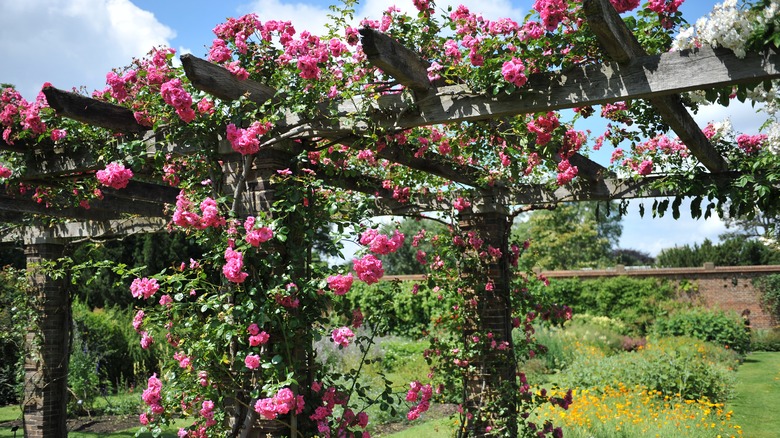Cover Your Garden In Endless Climbing Roses With These Propagation Tips
If you've been searching for how to design and plant the perfect cottage garden, you'll no doubt come across some gorgeous images filled with luscious climbing roses. There are plenty of benefits to growing these plants in your yard. For one, they're deer-resistant while still attracting birds and pollinators with their rich foliage and fragrant blooms. Unlike other types of roses which can be tricky to maintain, climbing types are relatively easy to grow. Additionally, with these trailing, fantastical blooms, you can never have too much of a good thing. In fact, propagating several climbing roses throughout your yard will only add to their whimsical appeal. To ensure your climbing roses survive and thrive after propagation, it's crucial to take cuttings from the right place, transfer them into the correct medium, and provide the proper conditions and support for the newly-transferred cuttings.
Successfully propagating these plants can take a bit of time, but it's well worth the effort to fill every corner of your garden with climbing roses that are absolutely stunning. While they love to spread naturally, by following a few propagation tips, you can ensure they fill your yard right where you want them. Here are the best propagation methods and tips for transplanting gorgeous climbing roses throughout your yard.
The tried-and-true way to propagate climbing roses
There are a few processes you can follow to propagate your climbing roses. For the first method, start by locating fresh stem growth from the current season. Propagating is best done in late spring or summer while these new stems are still tender but have grown to a substantial enough length. Use shears to take a cutting between 8 to 12 inches long, snipping just below two parallel leaves at a 45-degree angle. Next, pinch off most of the leaves, leaving just a few at the tip of the stem. Fill your propagating container with potting soil enriched with compost and perlite, then insert the rose cutting into the soil. Place your propagated rose in bright indirect light and ensure the soil is moist but never soaked.
To increase the odds of successful rooting and propagation, you can dip the end of the rose cutting in a rooting hormone like TakeRoot, available at Lowe's, before planting. Adding a humidity cover or dome over your pots may also help the cuttings retain moisture. After about two months, your climbing rose cuttings should have sprouted a few new leaves and developed their own root system. At this time, you can place them in an area with direct morning sunlight and afternoon shade to encourage growth and help them build strength. By the following spring, you should be ready to transplant them into their permanent location in the ground or a pot.
Alternative ways to propagate and encourage climbing roses
With the above propagation method, you may not be able to transfer your roses until the next spring, but YouTuber Milk and Honey Acreage offers some alternative methods that could lend faster results. First, search for a limb that is already stretching sideways from your main plant. These horizontal stems often have roots of their own that are eagerly seeking soil. Cut and transfer this stem to another area, being sure to cover the roots in soil and keep them moist. Alternatively, you can find a set of rose suckers growing out of the ground nearby, then carefully dig about 6 inches around the root ball of these shoots, severing them from the mother plant before transplanting elsewhere.
Climbing roses can circumvent some aspects of what makes roses such difficult plants to grow in the garden, but that doesn't mean you should set them and forget them. When transplanting your roses, place straw or dry grass around the base to keep the soil moist. Furthermore, while their name might imply that these roses act like a vine, if you want your climbing roses to reach their full potential, you'll need to tie the branches onto the supports. A trellis, fence, archway or brick facade is an easy place to grow climbing roses and help them fill vertical space in your garden. Remember to also deadhead flowers to encourage blooming throughout the growing season.

